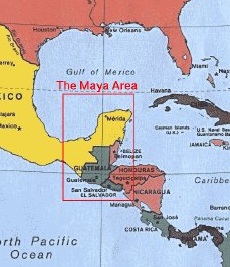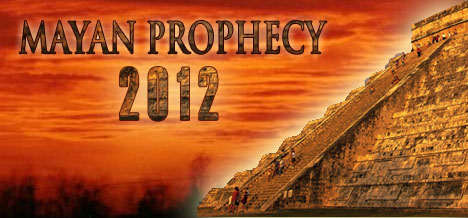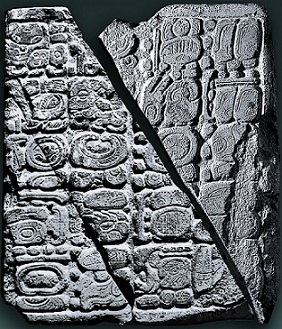
The Maya calendar comes to an end on December 21, 2012 and according to the ancient Maya the world is supposed to come to a cataclysmic end, right?
Wrong.
There isn’t a single document, script, writ, sculpture or mention by a single ancient Maya that states this. This is a cold, hard, fact. It’s not up for debate. If anyone says otherwise, they simply need to refer to the document by name. No one has done it and no one will, because it simply doesn’t exist. It’s a modern invention driven by a market that profits from fear-mongering and sensationalism. It sells books and magazines, makes millions at the box office, and gets people to read news articles.
So what is going on? Where did all this end of the world talk come from? Who started it? Doesn’t the Maya calendar come to an end on December 21, 2012 like we all heard? How can millions of people be wrong? Everyone is discussing it. What exactly did the Maya say about this particular date? Who were the Maya anyway? Read on.
The Maya; Pre-Colombian Mesoamerican Giants
The Maya are a pre-Colombian, Mesoamerican people originating from what is today southern Mexico, and parts of Guatemala, Belize, Honduras, and El Salvador. It’s not exactly known when the Maya made their first appearance. According to the Popol Vuh, which is their written account of creation, three “worlds” or cycles have already passed and we are in the fourth which began on August 11, 3114 BCE. Each cycle lasts 5,125 years. By their account, that would place their origin some 20,000 years ago. Modern scholars have a more conservative opinion and place their origins at approximately 2,000 BCE, possibly a bit earlier.
The Maya as a major civilization  lasted until their conquest with the arrival of the Spanish in the 16th century, where their numbers dwindled but did not disappear. There are still ancestors of the Maya living today, and as a matter of fact, there is a rather large population of Maya from Guatemala in New Bedford.
lasted until their conquest with the arrival of the Spanish in the 16th century, where their numbers dwindled but did not disappear. There are still ancestors of the Maya living today, and as a matter of fact, there is a rather large population of Maya from Guatemala in New Bedford.
While there were Paleo-Indians, various peoples and minor settlements in the region as far back as 10,000 BCE, the Maya were one of the first major civilizations, if not the first. Meso-American history is characterized by cultural diffusion and many of the firsts in the Americas. It’s difficult to concretely pinpoint which civilizations were responsible for some of these firsts such as writing and urban planning, but it is generally agreed that they can be attributed to the Olmec, Maya, and Zapotec. The Olmec are important to the story of the Maya because they likely inherited from them the basic calendar that the modern world is currently discussing in books, the news media, and internet. Who came first and who is responsible for the firsts, is not a topic that falls within the scope of this article.
While the early dates mentioned above only approximate when these cultures made their appearance, they don’t reflect the dates when they became true major civilizations with city-states, astronomy, engineering, urban planning, writing, commerce, architecture, etc. These came much later. For the Maya in particular the period that reflects these major developments coincides with their Classic period that begins circa 250 ACE, although their writing began a few centuries earlier around 250 BCE.
Maya Writing and Documents
While the Maya script or writing system may or may not be the first example of writing in the Americas, it is the only example of a system that represents the spoken language of the community. Along with being the most complete, developed and complex writing system of Pre-Colombian America, it is the one system that has been deciphered the most with at least 10,000 texts on stelae, monuments, pottery, stucco, tombs and even paper made from bark called huun-paper. This has lead to a greater understanding of their culture in comparison to their contemporaries. The system of writing was in use to at least the arrival of the conquistadors, when it began to wither until it’s re-discovery and decipherment by scholars in the 19th and 20th century. It is currently undergoing a sort of revival in some parts of Mexico with Maya peoples and support from the government.
In appearance, the script resembles small images or pictures, similar in fashion to Egyptian hieroglyphs, but unrelated and certainly different. The writing is made up of logo-grams complimented with syllabic glyphs. In the simplest of possible terms, this means that each glyph can be either a syllable, a word or even a few different words. It’s a similar structure to that of the Japanese language with it’s Kanji characters complemented with the Hiragana and Katakana syllabary. A number of languages utilized this script, just as German, Spanish, English, and many other cultures currently use the Latin or Roman alphabet.
Maya Calendar; Origins
As mentioned before, pre-Colombian Mesoamerica is characterized by cultural diffusion. The Maya calendar is based on a system that many Pre-Colombian cultures were using by the 5th century BCE. The Maya took the existing calendar and refined and improved upon it. The sheer amount of script that has been found and deciphered greatly contributed to the understanding of the Maya calendar in particular in comparison to others. The Maya calendar is incredibly complex and a full volume would be needed just to touch upon basic elements of it. For the purposes of this article we will discuss only the pertinent elements and for the sake of practicality will simplify our discussion, even at the risk of upsetting Mayanist scholars.
By the time the Maya were using the extant version of the calendar, it was made up of two basic cycles, a 260-day count called a tzolk’in and the more familiar 365-day count called a haab. The tzolk’in, which is still in use by the Maya today was not an astronomically based calender, but a ritual calendar and is the most important and oldest. It was used to determine when to harvest maize, set auspicious days to have marriages,  build homes, determine names, initiation ceremonies and other rituals.
build homes, determine names, initiation ceremonies and other rituals.
The haab was the same length as our solar-based year but divided differently. Since a “true” tropical or solar year is 365.25 days long this .25 day presents a problem for any civilization that utilizes a calendar and wants to maintain synchronicity. Our current calendar is made up of twelve 28, 30 or 31 day periods that total 365 days, so in essence we ignore that .25 of a day each year. After 4 years we have “lost” a day, so we solve this problem by adding that day back in every fourth year, called a leap year.
The Maya approached this problem by, well…”ignoring” it in a way. The 360 day period called a tun was capped with a 5 day period called wayeb’ to total 365 days. Essentially “losing” a full day every four years just as happens in our modern calendar. However, there was a genius and a larger purpose behind this. It meant every season, year or event started on a different day giving an altogether new auspicious meaning to each passing event and year as a whole. Somewhat similar in meaning to how the Chinese will have a year of the Dragon, Dog or Snake. Because these events “wandered” through the calendar, this is called a wandering year.
The tun or basic year had 18 “months” called a winal that were 20 days long. There were smaller divisions, such as 13 and 20 days, and many larger counts, such as the Ka’tun which was twenty 360 day periods, and the Calendar Round which is approximately 52 years long. Next is the Baktun, which is integral to this article, and is approximately 394 years long, the Pictun which is 7,885 years long, and the Kalabtun which is 157,808 years long. There’s even more. We then have the K’inchiltun which is 3,156,164 years long and finally the Alautun which is over 63 Million years long!
Cycles within Cycles
What should be immediately apparent is that an Alautun is made up of many K’inchiltun, and many more Kalabtun, and so on. There are cycles within cycles. If the Maya calendar’s third world began in 3114 BCE and ended according to the Doomsday theory in December 2012, we have a period of slightly more than 5,000 years. Not even one Pictun! It is a period of 13 Baktuns, and that alone demonstrates that after each Baktun concludes, not ends, a new one begins. Since the calendar has counts in the tens of thousands, hundreds of thousands and millions of years, it’s obvious that the Maya calendar is far longer than 5,000 years long. This standing on its own is a death knell to the doomsday theory.
Just like we use years, decades, centuries, and millennia the Maya used their own system of cycles. To imply that a calendar ends after the completion of a decade, century or millennium would garner a laugh and is absurd on the face of it. They simply conclude and begin anew. The exact same can be said about the Maya calendar. To imply that the world would come to an end because a calendrical event like a Baktun concludes and is starting over is just as absurd. The Maya calendar keeps on counting and December 21st, 2012 is simply the beginning of the 13th Baktun. Altogether this 13 Baktun period has been dubbed ‘The Long Count.’
Maya References to the ‘Long Count’; The Tortuguero Monument
Is the conclusion of a Baktun in general or the ‘Long Count’ of 13 Baktuns specifically of special significance to the Maya? What do they say about this specific date? Do they mention any dates after this one?
In 1915 in Tabasco, Mexico an archaeological site called Tortuguero was discovered and unearthed. This Mayan site had a number of inscribed monuments on it dating to the 7th century. It is one of these monuments, Tortuguero Monument 6 that mentions the 13th baktun. This is the sole mention of the 13th baktun in the entire archaeological record. Yes, all the modern day madness culminates from this one sole inscription. Here it is in all it’s glory:
The 13th baktun will be finished.
On 4 Ajaw the third of Uniiw ? will occur.
It is the display of B’olon-Yokte’
in a great investiture
What we can garner from this short passage is that when the 13th baktun comes to an end, something will occur that is related to Bolon Yokte in a great investiture. Bolon Yokte [Kuh] is a deity that is closely associated with conflict, war, and the Underworld. He is often mentioned in creation myths of the Maya. He is a very powerful deity and important events are attached to his presence. An investiture is a formal ceremony where a title and authority is conferred.
For starters, the passage is woefully incomplete. While this has left room for anyone to interpret the passage to coincide with their agenda or theory, any healthy, balanced perspective would take into account its incomplete nature and therefore suspend a conclusion. Especially one as hugely significant as the end of the planet and/or humankind or some variation thereof. Of course, a rough interpretation can and should be made, but it should be made by those with a background, experience, and deep knowledge of Maya script, culture, and mythos. The consensus among the experts is that a doomsday theory is neither suggested or implied and it simply doesn’t exist among educated opinions.
Mayan Astronomy
Another advancement the Maya are well known for is astronomy. They had a highly advanced system and knowledge of astronomical events and interwove it with their mythos and in more practical matters like city planning and agriculture. The astronomical event that is tied in with the 13th baktun and Bolon Yukte is that the winter solstice sun rises in conjunction with our galactic center. Nowhere is a mention of earthquakes, comets, meteors, asteroids, destruction, or catastrophe. It’s neither implied nor suggested. It is a Eurocentric and western view that the Underworld is attached with evil, bad, catastrophes, etc. What has happened is New Agers came to the conclusion that since a deity that is associated with the Underworld would be present at the end of an era, it must mean we’re all going to die! Silly, childish, immature, and certainly a very uneducated conclusion to the passage on Tortuguero Monument 6. However, it DOES sell books, DVDs, and generate revenue. Hence, it’s presence in popular culture.
End of the World Prophecies through History
Armageddons and end of the world prophecies are nothing new. Hundreds have come and gone. On James Randi’s website alone he names 44 end of the world prophecies through time. My personal favorite in modern time was the 05/05/05 prophecy. May 5th, 2005 was the date 5 planets in our solar system would align. The gravitational pull would rip our planet to shreds. Books and DVDs filled the bookstores. Documentaries were made. Some of the books were well-written by very intelligent people, backed with seemingly sound science. Of course, 05/05/05 came and went like any other day. The point is that the western world is infatuated and deeply in love with end of the world prophecies. The media is infatuated and deeply in love with sensationalism that generates revenue. The perfect formula for a doomsday prophecy that enters pop culture and becomes mainstream.
As mentioned earlier, the Maya still exist today. Many, if not most are unfamiliar with the prophecy, even though aware of Tortuguero monument 6. Those who are aware of the prophecy, find it absurd and laughable at best, and western and/or Euro-centric arrogance at worst.
So you can stop collecting canned goods and building that underground bunker!
 New Bedford Guide Your Guide to New Bedford and South Coast, MA
New Bedford Guide Your Guide to New Bedford and South Coast, MA










Great writing Joe!
very scholarly article, Joe… can’t wait to share it with my doomsday girlfriend and disaster loving co-workers!
Thank you guys!
Found a recent article of a discovery of wall of inscriptions discussing dates far after this year. Video included.
http://phys.org/news/2012-05-ancient-maya-calendar.html
Mr. Silva:
You make a subject that can be dry and boring come alive! It is clearly evident that you have honed your craft!
Call me a fool, but I wasn’t stacking canned goods, i was collecting photography books and UFC dvd’s… lol at me!
Great article and thank you!
~iggy